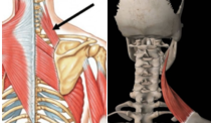What is the Levator Scapulae (Lev Scap/LS) Muscle and How It Can Affect Neck and Head Tension?
Posted on 23rd July 2020 at 10:00
The Levator Scapulae is a skeletal muscle situated at the back and side of the neck. The Lev Scap, or LS, as it’s affectionately known, influences both neck motion and upper back posture.
The Lev Scap is a muscle that’s often implicated in pain or dysfunction in the upper area of the body because it can become chronically tight, shortened and overactive, exerting its effect on both scapula position and cervical spine movements. Associated neck and shoulder pain/tension is a problem commonly faced by office workers, truck drivers, and others who sit all day on the job.
What does it do?
One of the Lev Scap’s primary jobs is to keep your shoulder blade in a position that supports a vertical alignment of your head on your neck, and to prevent forward head posture, a condition in which your head is too far forward.
Sitting for long periods of time with poor posture puts a lot of stress and pressure onto various muscles in the neck and back, including the Lev Scap muscle. Over time, this constant stress and pressure can irritate the Lev Scap, inflaming it and causing it to become sore, which can also lead to headaches and repetitive strain to the upper body.
How tension can cause headaches
Headaches are among the most frequent pains we suffer from, perhaps because they have so many triggers. Emotional stress, poor food choices, and poor posture can all lead to aching, throbbing, or tension pain in our heads. In the trigger point therapy field, we know that the secret to relieving headaches often lies in treating the muscles that refer pain into the head. The most important of these muscles is the Upper Trapezius, which leads to other muscle tension build up.
What can be done to help?
To avoid problems with Lev Scap, try to stretch your neck daily, do postural exercises, and take frequent breaks to help prevent chronic pain.
Deep Tissue Massage can help prevent injuries from happening from repetitive strain on the body. That is why having a massage every couple of weeks can really improve your health.
STR - Soft Tissue Release - on a weekly basis for two months or so will help you if you’re experiencing constant aches in this area.
Lev Scap:

Trapezius:

Stretching these muscles out frequently surrounding your upper body will help release these tensions:
Neck Flexion
Neck Flexion with Side Flexion
Mid-Scalene Sternocleidomastoid Stretch
Levator Scapulae Stretch
The following diagrams show some simple but effective stretching exercises you can do to ease off your neck and surrounding areas.
To book a massage to help with these issues please contact us today.




Share this post:

